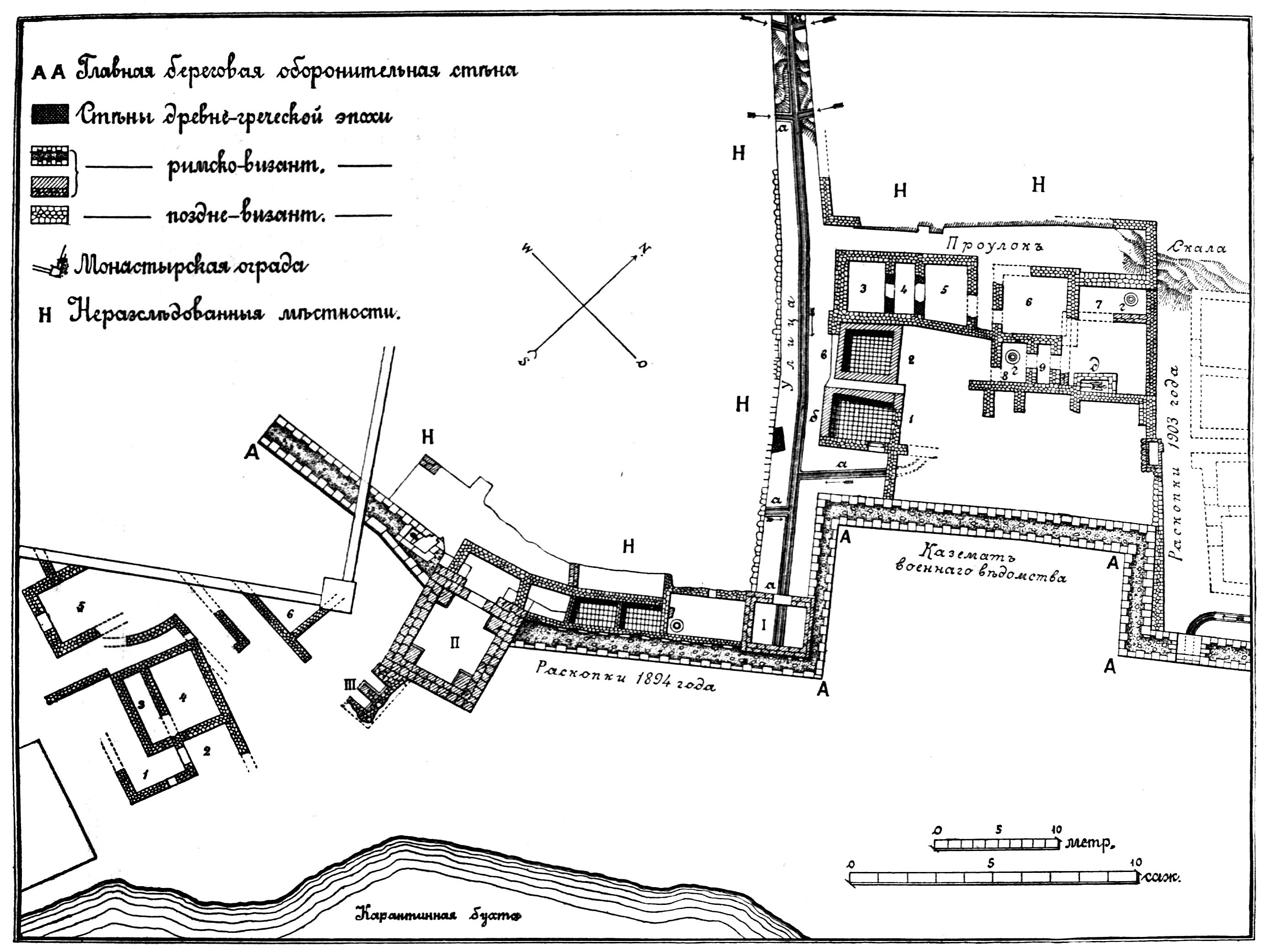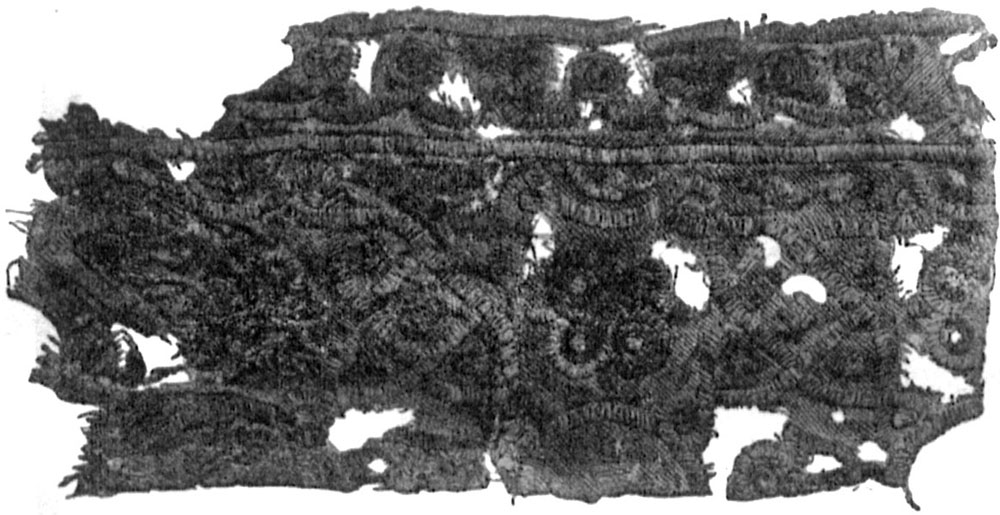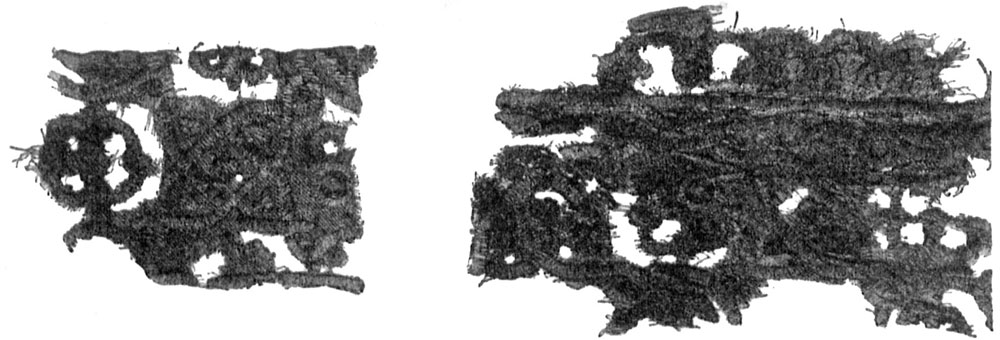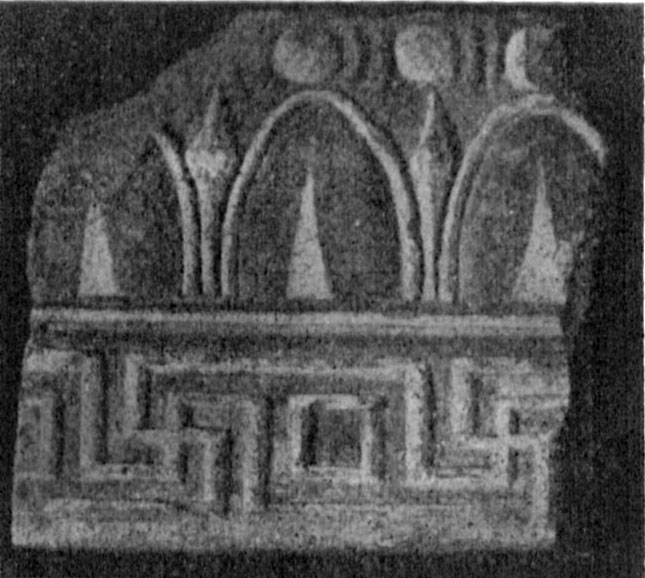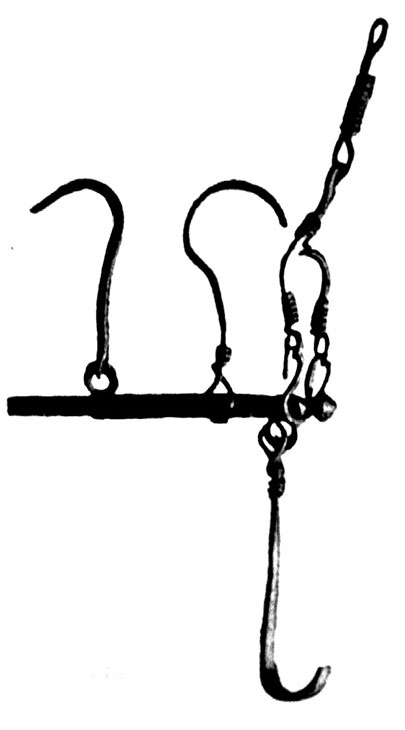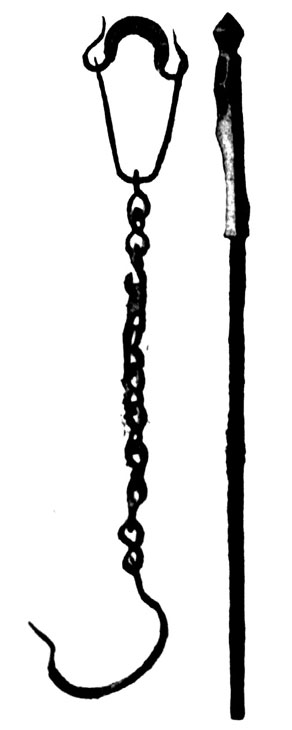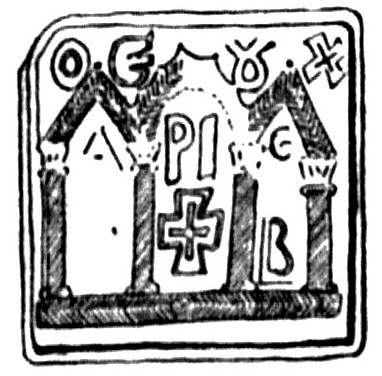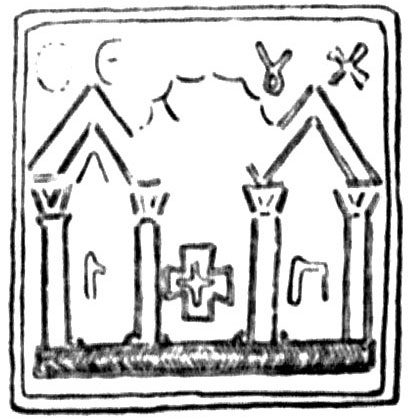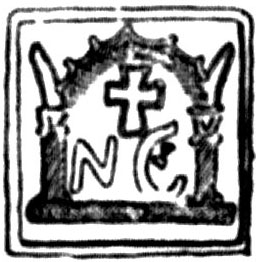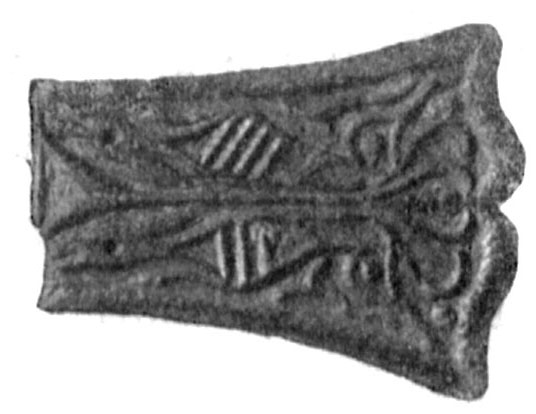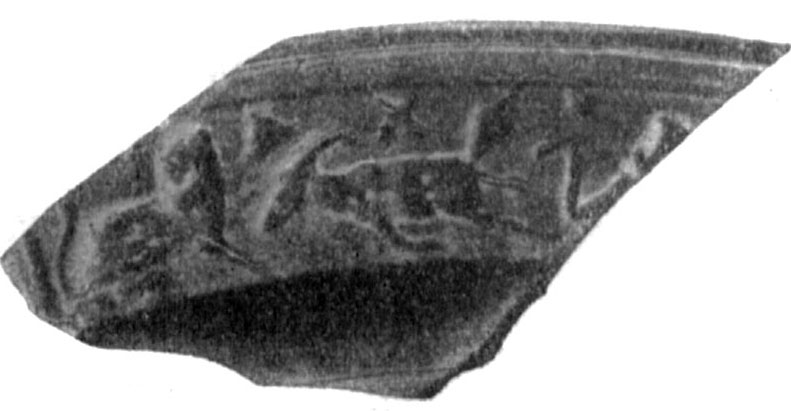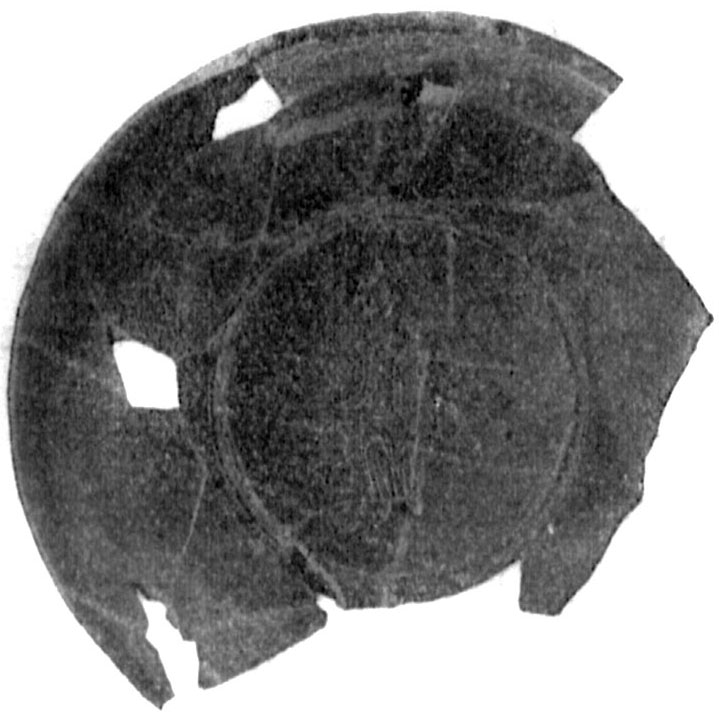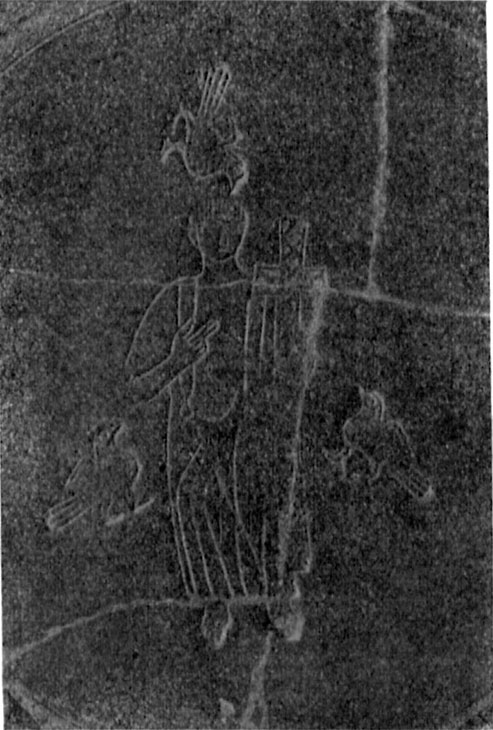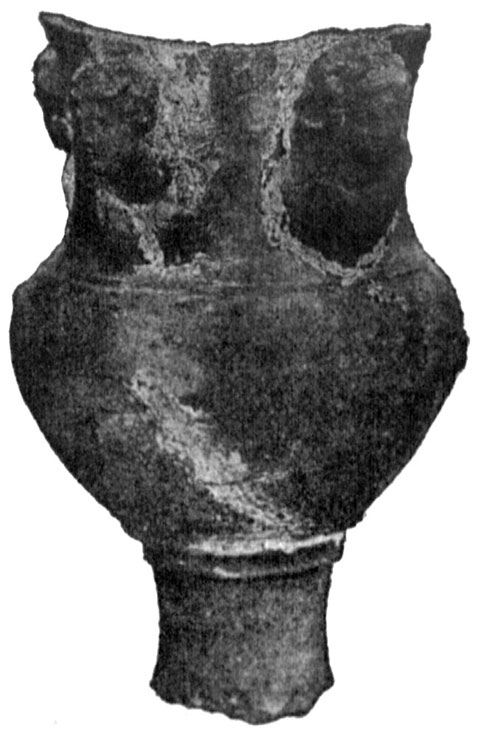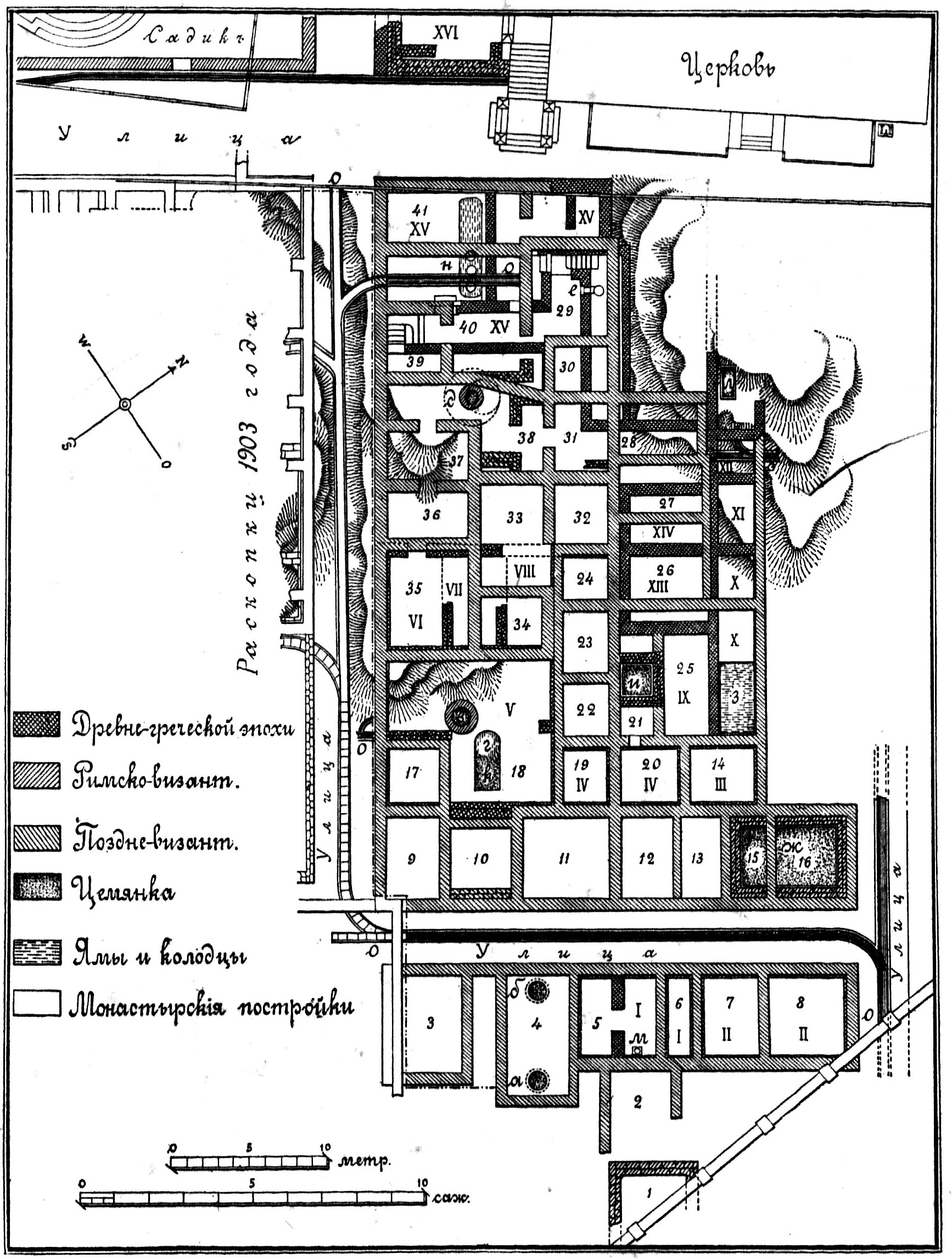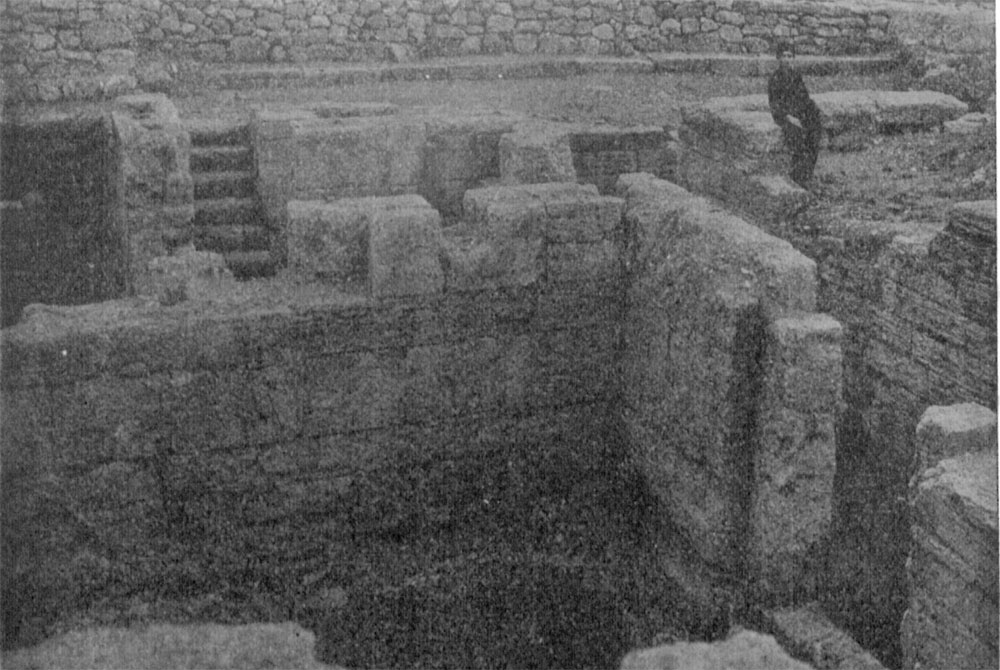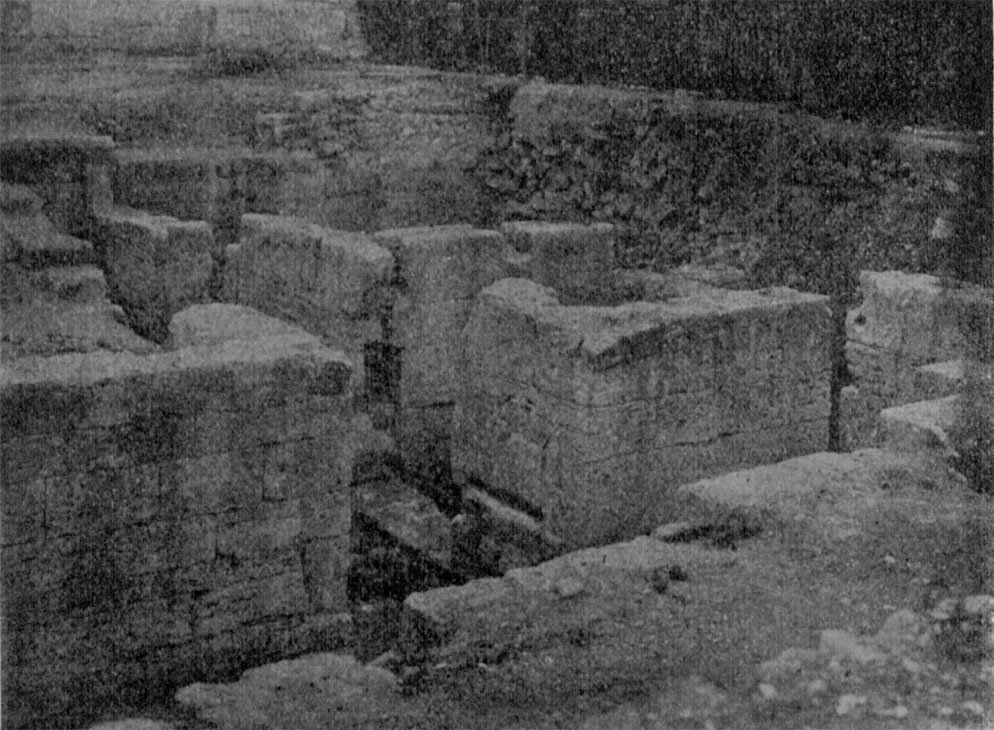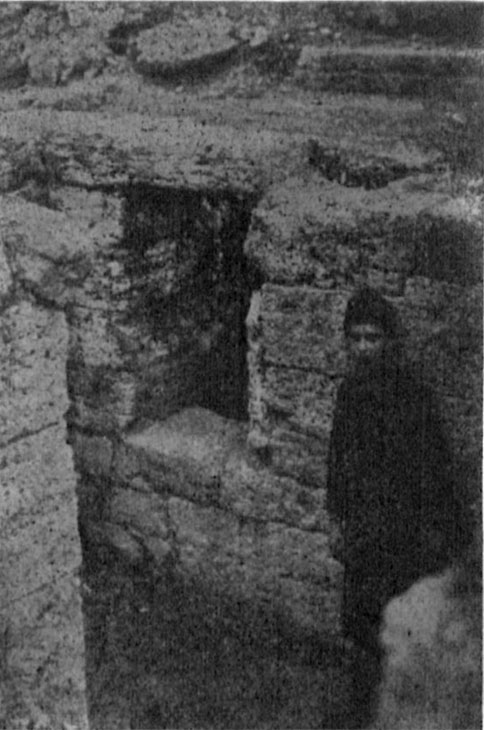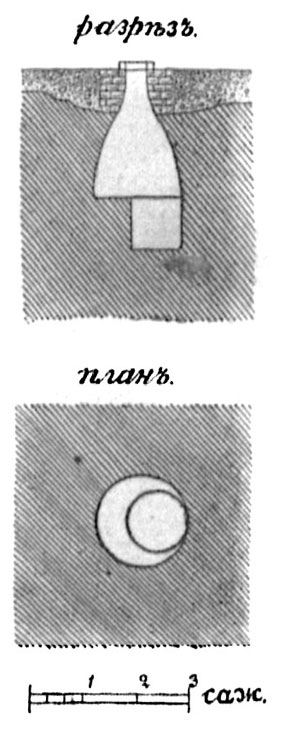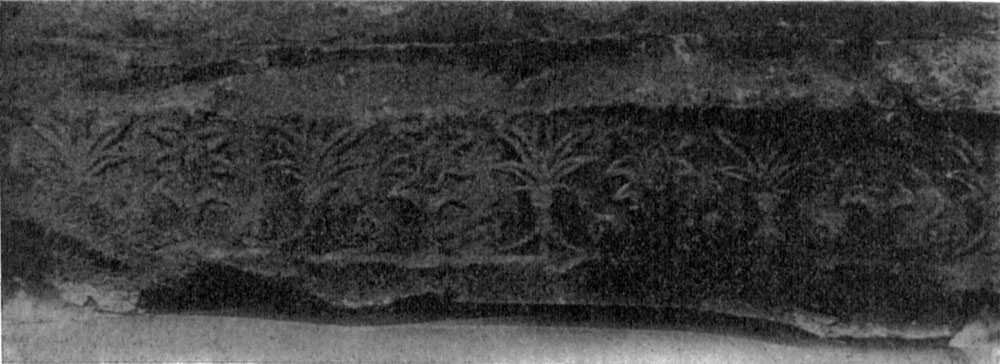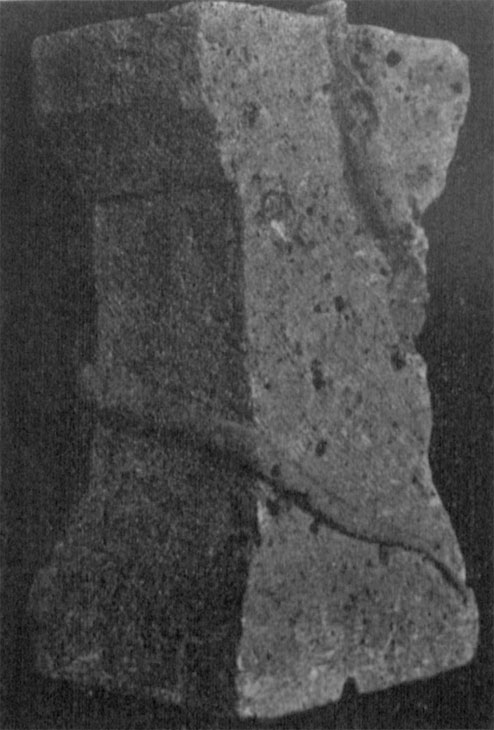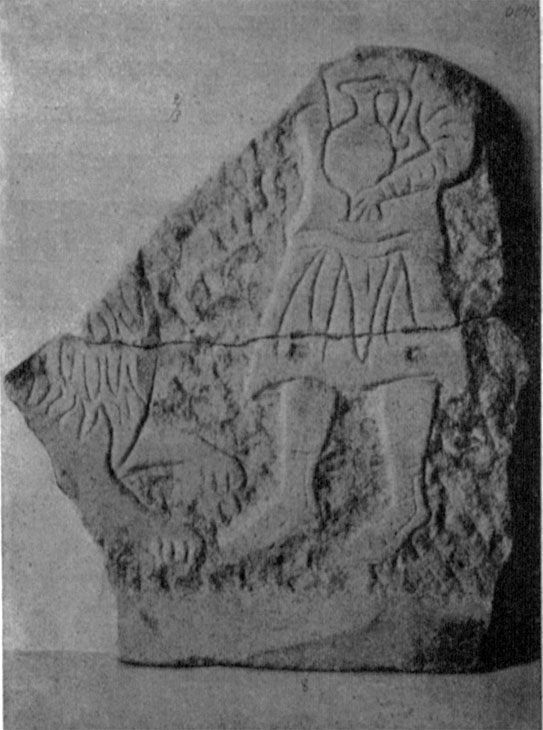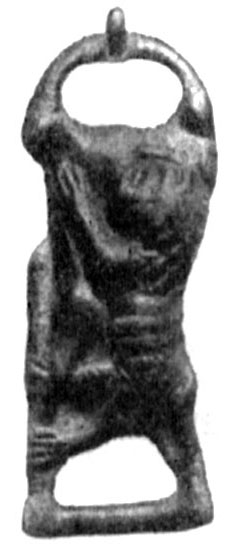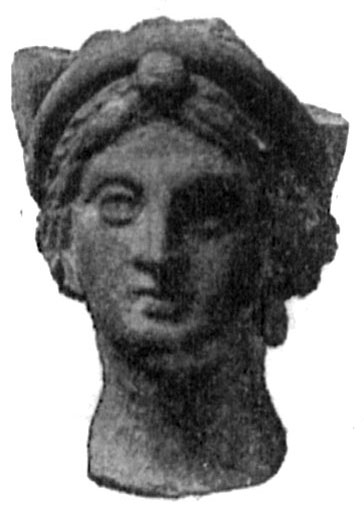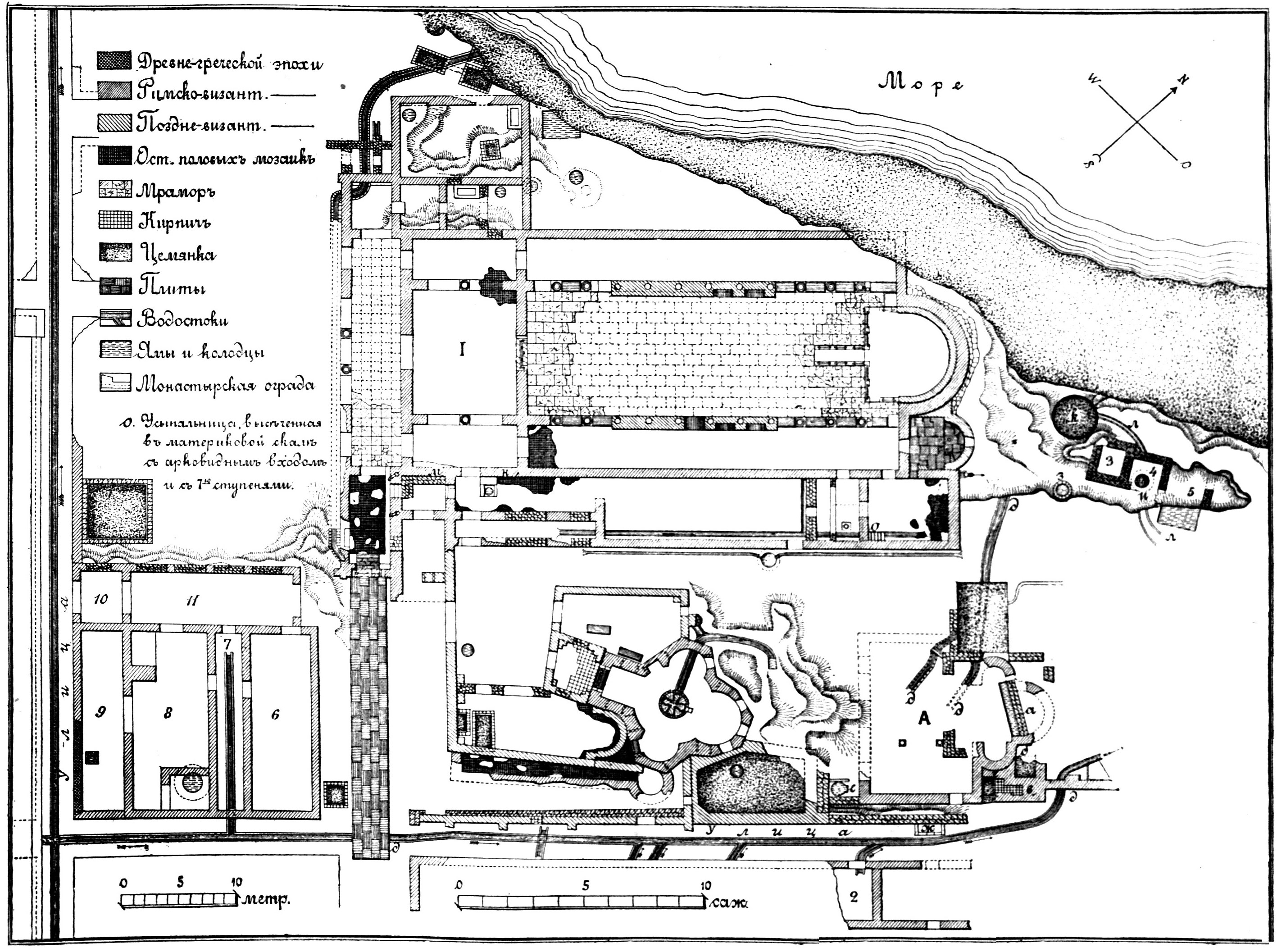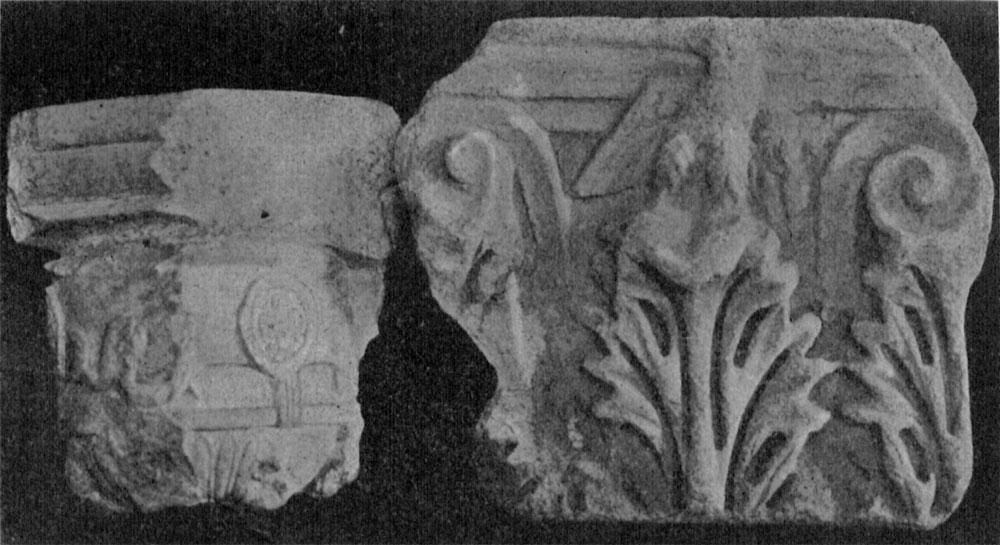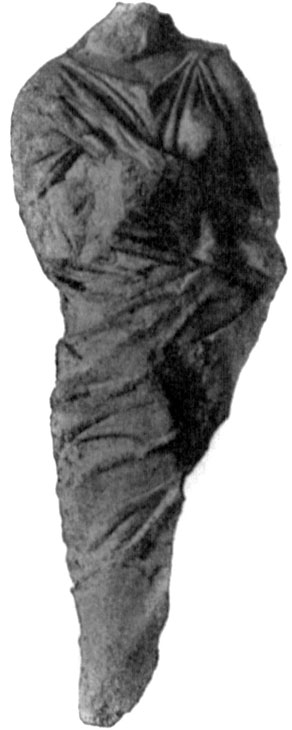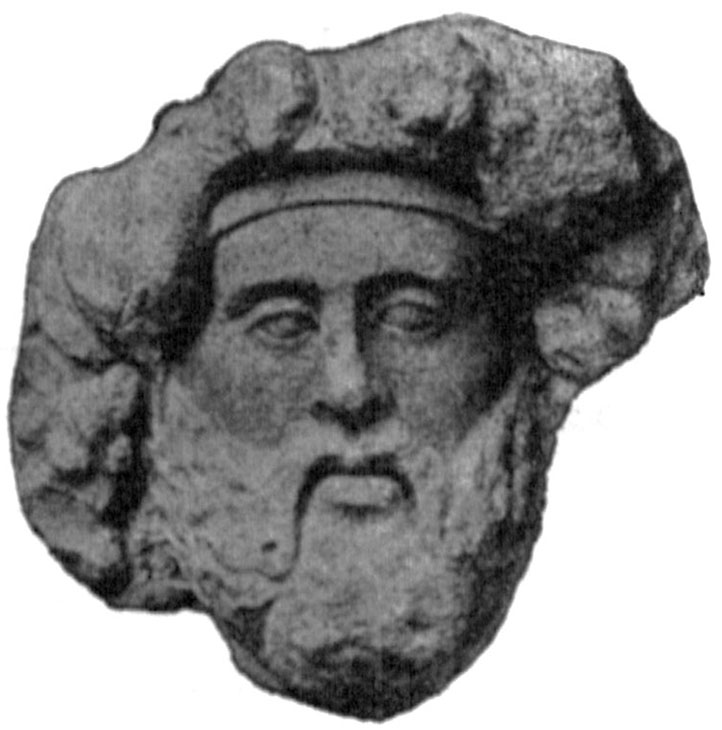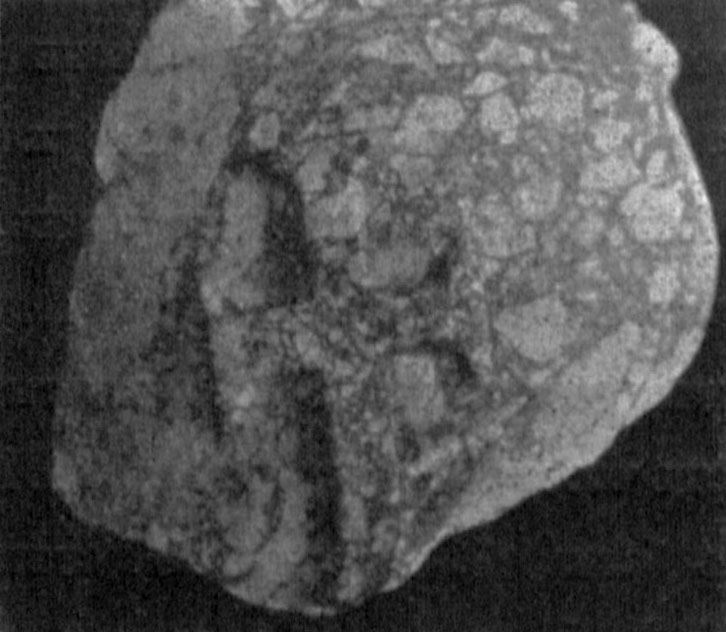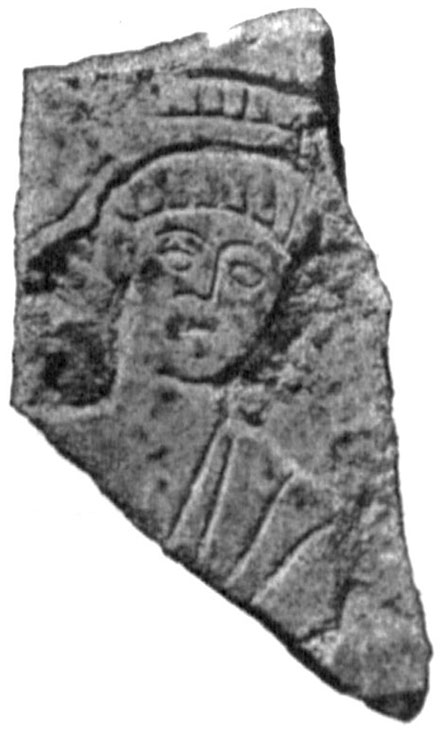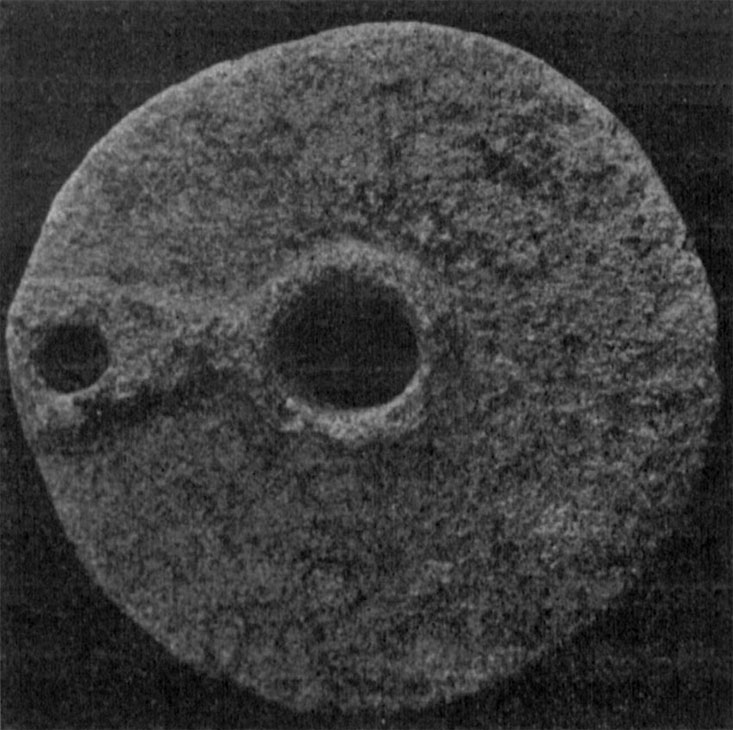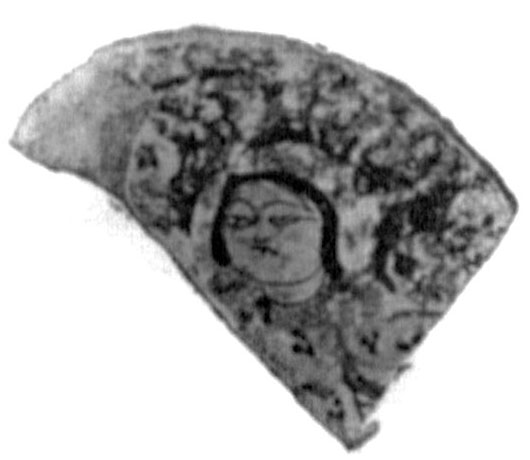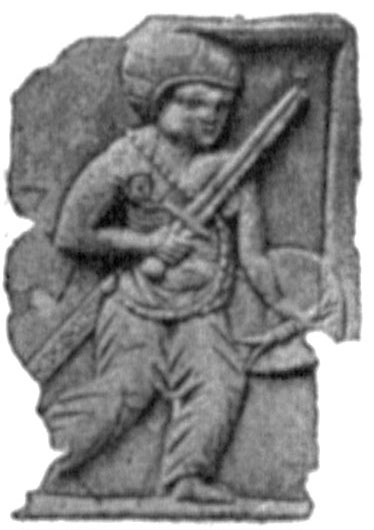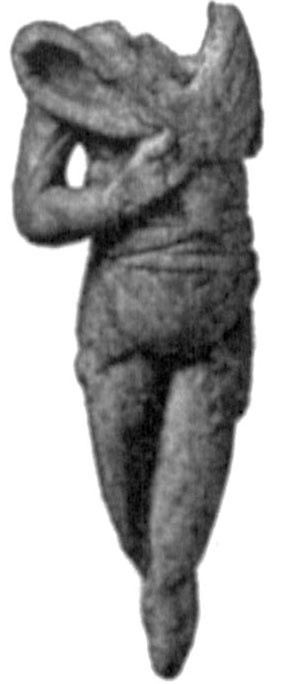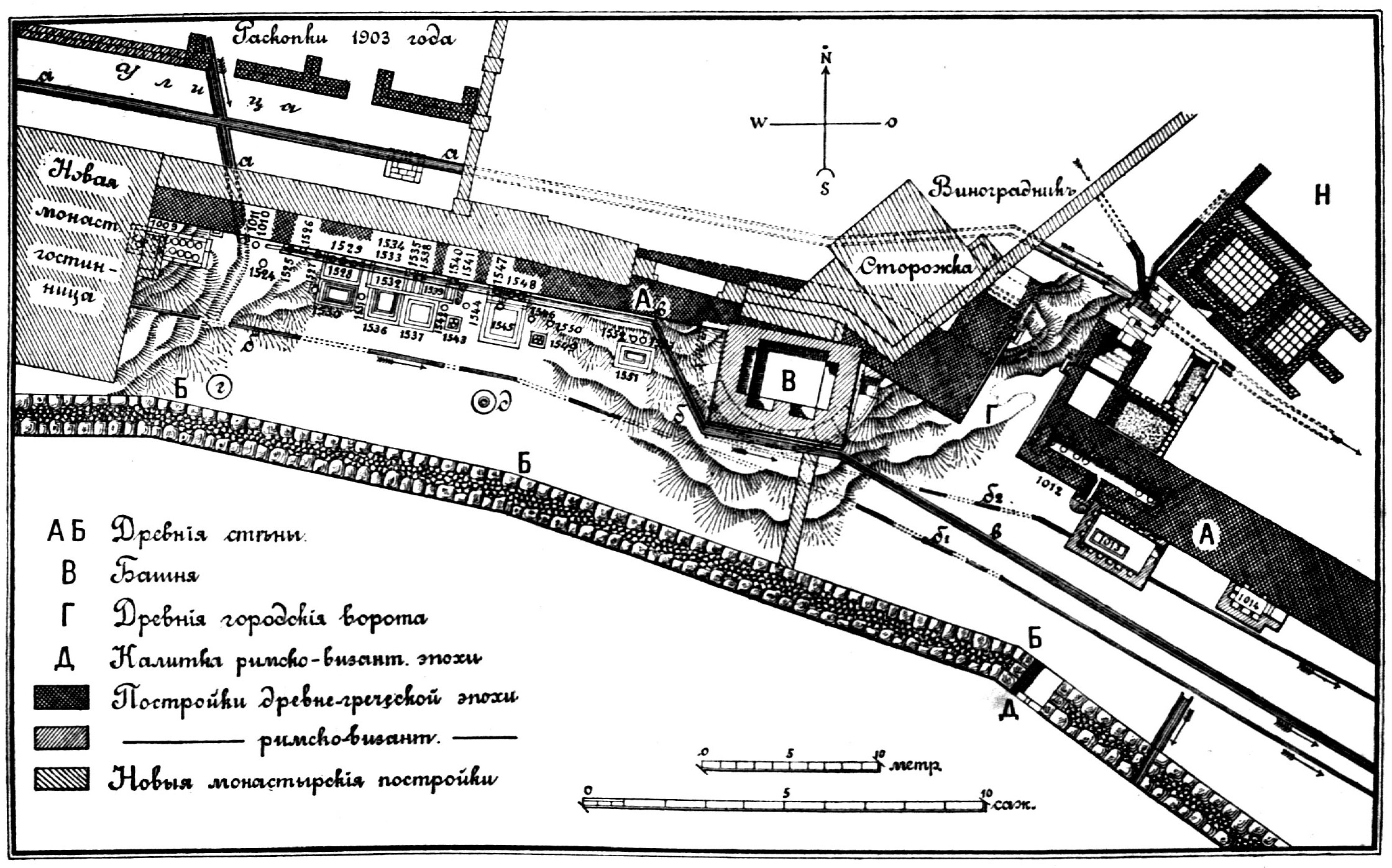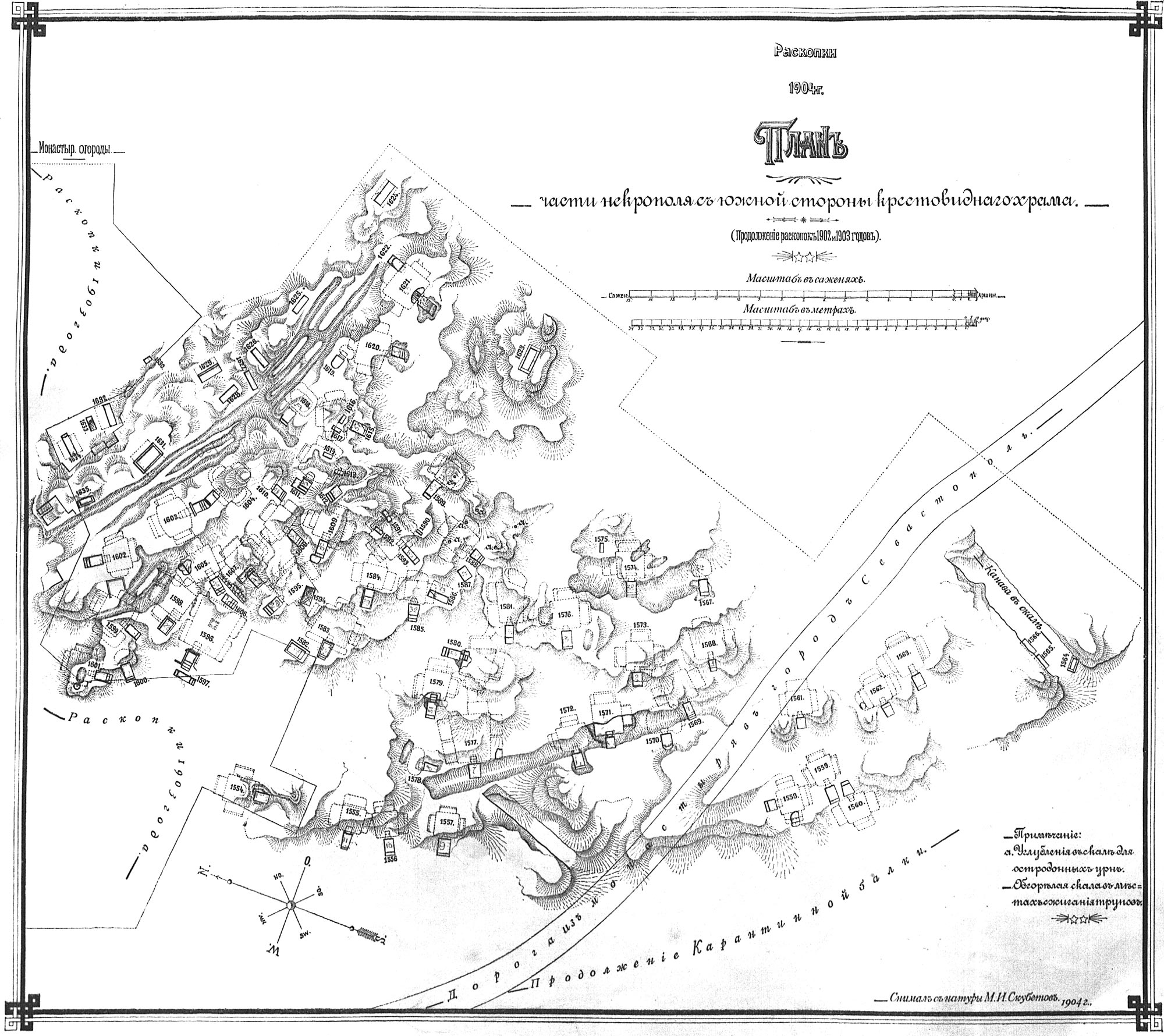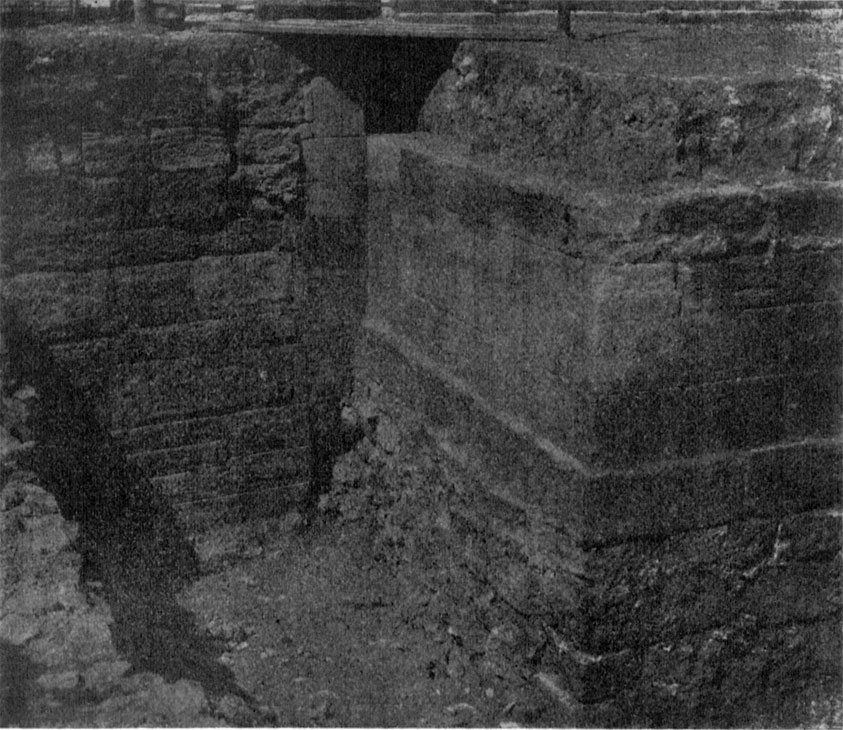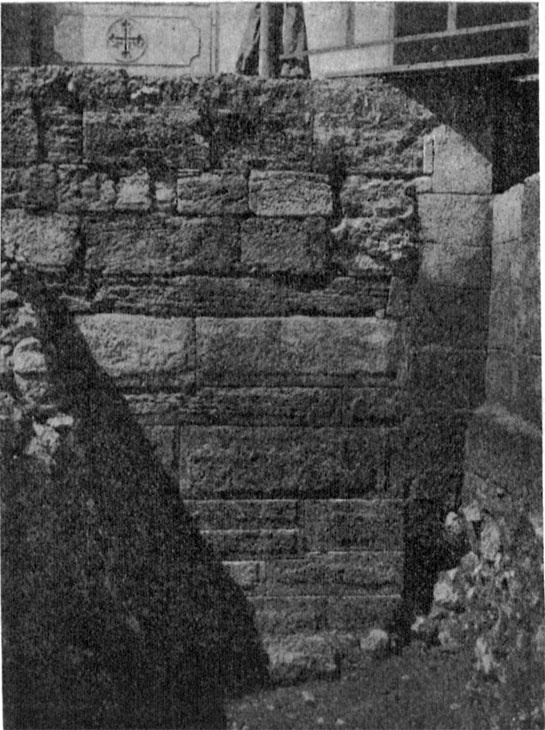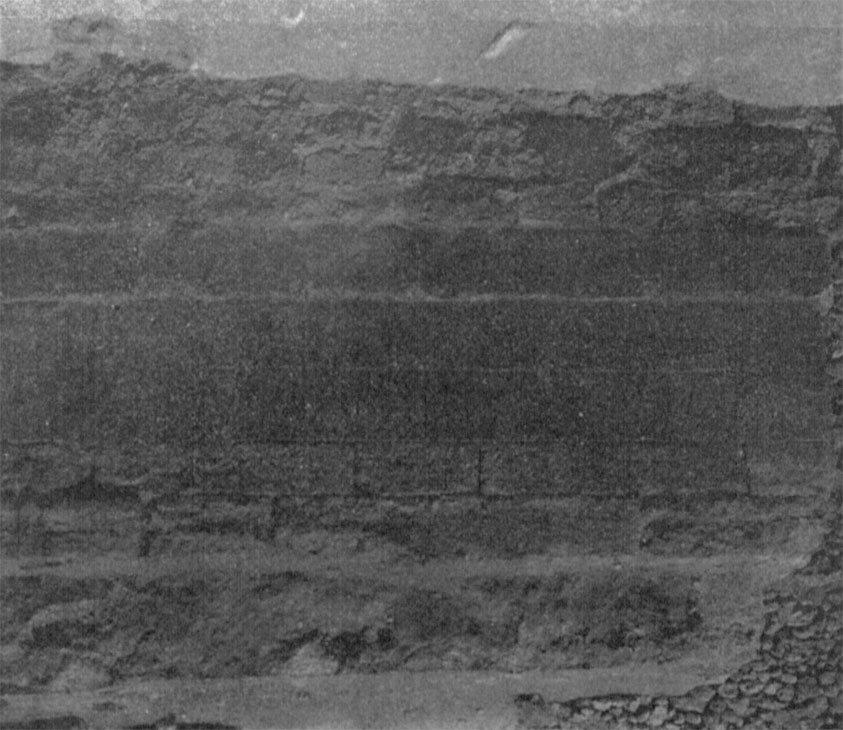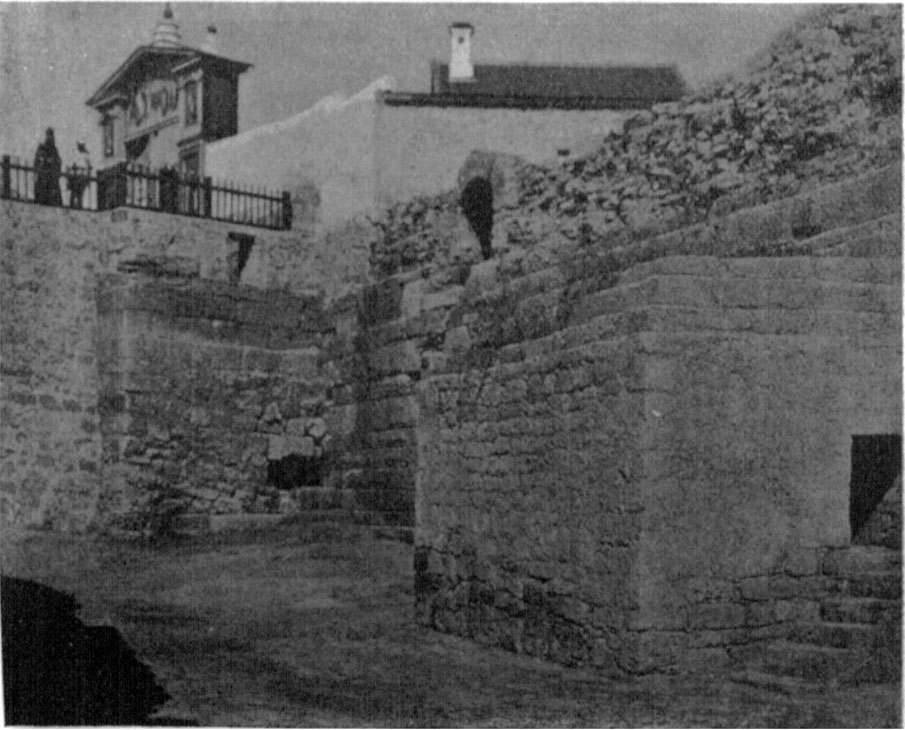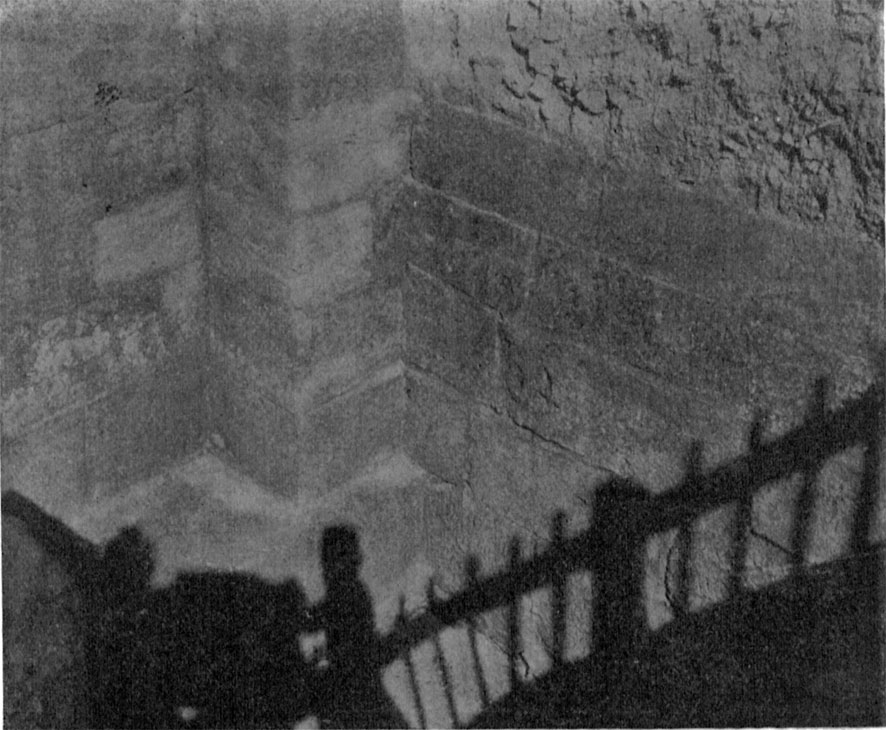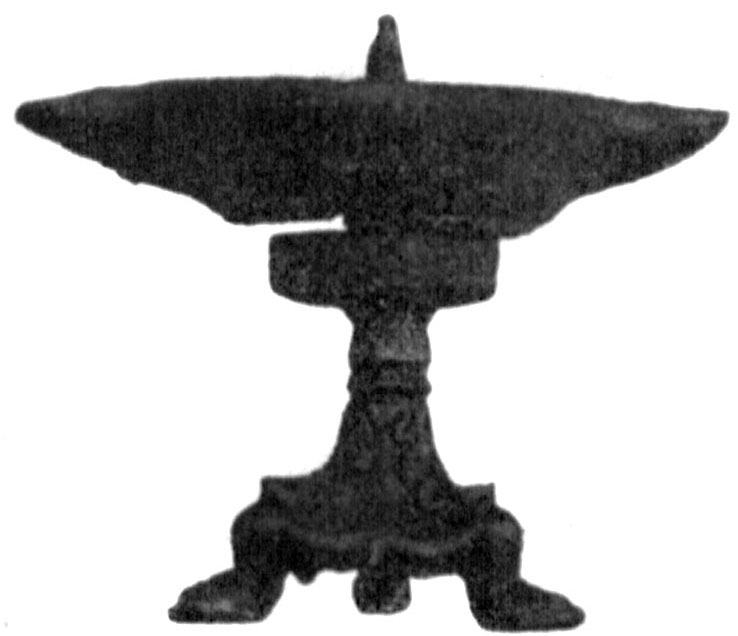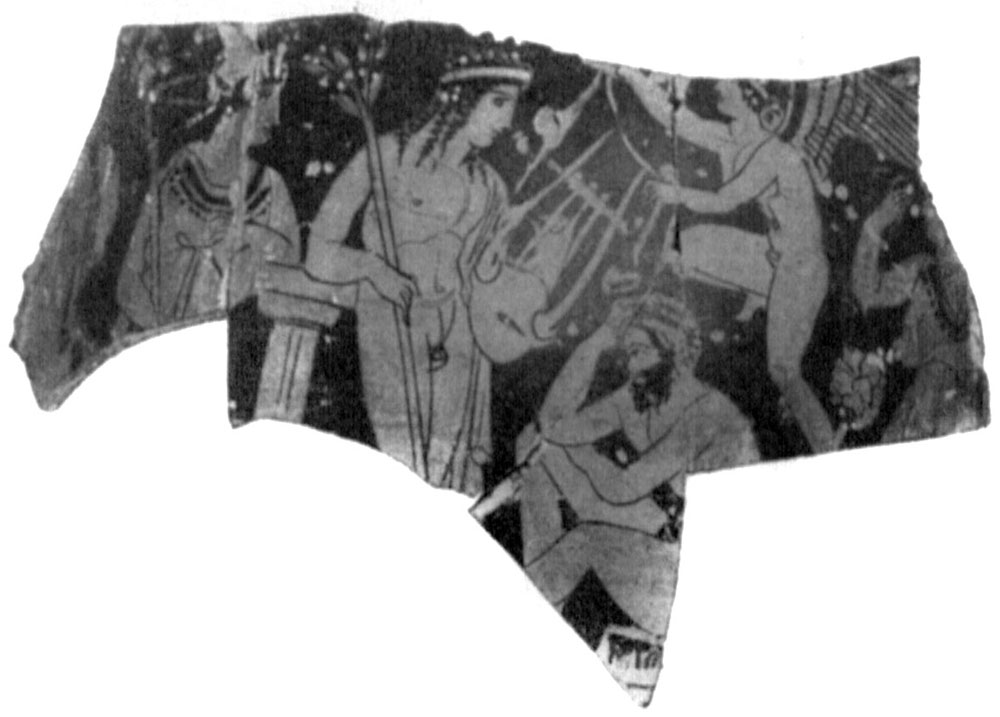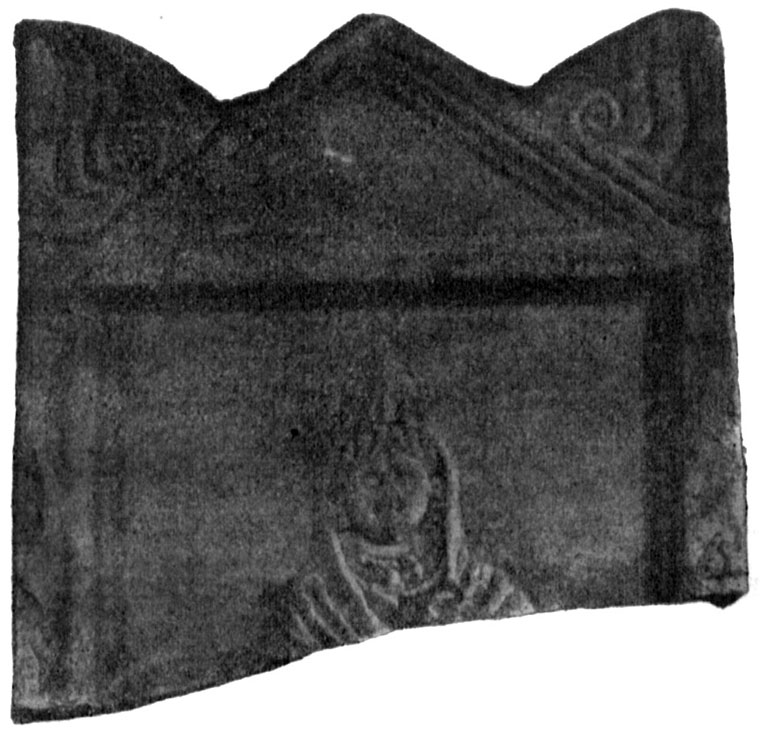1904 REPORT OF THE HEAD OF THE EXCAVATIONS IN CHERSONESOS MR K. K. KOSTSYUSHKO-VALYUZHINICH
Excavations in Chersonesos
In Chersonesos, the member of the <Archaeological> Commission K.K.Kostsyushko-Valyuzhinich has investigated in the year under report:
- an area near the warehouse of antiquities (to continue 1903 works),
- a part of the area within the monastery wall (to continue 1902-1903 works),
- an area near the Uvarov basilica and baptistery (to continue 1901 works), and
- parts of the necropolis: one to the south of the ancient Greek-cross plan church (to continue 1902-1903 works), another near the monastery gate (to continue 1898-1899 works).
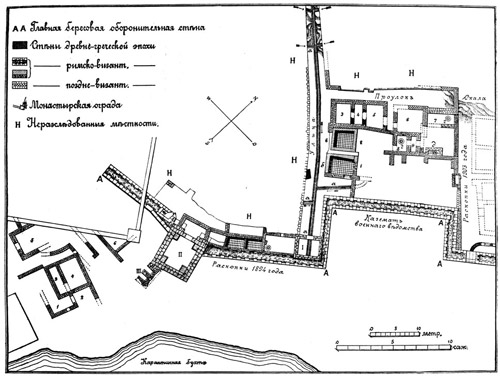
|
| Fig. 62 |
1. In the first of the mentioned areas
(see plan Fig. 62)
, the excavations were made just to the west of 1903 works. They discovered a group of urban buildings located to the west of the street unearthed in 1903. On the north, this group is restricted by a side-street, discovered in the year under report, which reached 1903 street. To the west of the buildings of this group, the excavations uncovered a street that was parallel to 1903 street and, similarly with the latter, reached bedrock on the north. Farther westwards, along the city wall, the excavations unearthed several buildings at the inner side of the wall and remains of buildings on the south, on its outer side. All the buildings and constructions discovered in this area date to different periods. The plan
(Fig. 62)
shows Ancient Greek, Romano-Byzantine and Late Byzantine periods as different shading. The excavations uncovered one broken pithos (г). in each of the Late Byzantine buildings nos. 7 and 8. In the room projecting southwards from building no. 7, there was a tomb with trapeziform ground plan
(д), , laid of rough stone and plastered. It appeared to contain few burials. One skull has visible traces of sabre stabs. Scraps of thick silk cloth with decorative satin stitch ornamentation
(Figs. 63
and
64
)
are the most interesting finds discovered in the tomb.
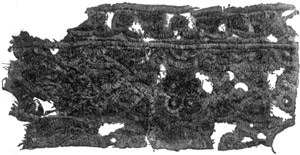
|
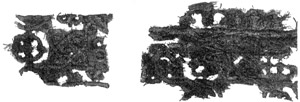
|
| Fig. 63 |
Fig. 64 |
Rooms nos. 1 and 2 were fit for trapeziform grain pits б and в, which were cemented and paved with square bricks. The excavation has discovered a layer of salt fish on the bottom of pit б and a drainage channel of stone slabs located on the street going from north to south, to the west of the rooms no. 1-3. In the excavated area, this channel receive six branches, three from either side
(а). In the Greek and Roman periods, this street finished at the city wall А, where rectangular tower I with the door (1.42 m wide) was located. In that period, drainage channel went under the tower, through the wall, and opened to the present Karantinnaya bay. Street drain was wider on the south, near the tower, than on the north, in order to let water pass without difficulties. When the sea wall lost its significance in the Byzantine period and various trade spaces and warehouses were annexed to it, tower
I was utterly destroyed. Now the street and the channel went higher than the foundations of the tower (the ancient channel remained below them). This year excavations have discovered that there also were buildings (warehouses, wharfs) at the outer side of the city wall, in the area around tower
II that was uncovered as early as 1894. There have been uncovered a part of wall III (it could be the sea wall of the city that reached the water) and buildings nos. 1-6.
The excavations in this area of the ancient city have discovered various ancient artifacts, the most interesting of which are the following: Greek and Latin inscriptions on marble slabs
[1]
, various architectonic fragments
(Fig. 65
represents a part of terracotta cornice, decorated with relief meander, eggs, and pearl-shaped ornamentation, with traces of white, brown and black painting), fragments of chancel barrier, fragmented round marble slab – a part of an altar, fragments of marble vessels, stone mortars, throwing stones, parts of bronze steelyards
(Figs. 66
and
67
)
, bronze weights
(Figs. 68,
69,
70,
71
)
bronze plaque with image of animals
(Fig. 72)
bronze medallions with glasses, fibula, buckles, pendants, finger-rings (there are some with carved decorations), spoon, thimbles, needles, fishhooks, various details of horse harness, arrowheads, crosses, fragments of a chain, fragments of a candlestick, fragmented mask of a woman, lead sinkers, clay sinkers in various shapes (there are some stamped pieces), clay and stone spindle whorls, clay playing balls, clay lamps (there are some stamped pieces), various earthenware pottery. The excavation has revealed a number of black-slip pottery. Among the red-slip pottery, there are interesting shard of lip of a plate with stamped figures
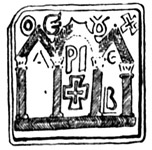
|
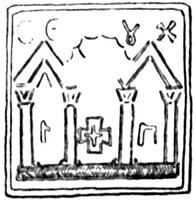
|
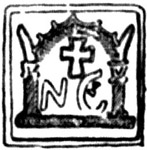
|
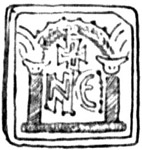
|
| Fig. 68 |
Fig. 69 |
Fig. 70 |
Fig. 71 |
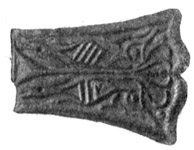
|
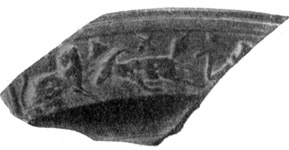
|
| Fig. 72 |
Fig. 73 |
(Fig. 73)
, fragmented plate with image of saint holding cross and three pigeons
(Figs. 74а
and
74б
)
, and fragmented tureen with stamped cross. Among the simple earthenware vessels, one should note fragmented vase
(Fig. 75)
with its top part decorated with three relief heads of women wearing ivy wreathes (maenads), made in the same mould. Besides that, there were finds of Byzantine glazed pottery and glass vessels,
round glasses for finger-rings, shards of glass bracelets, stamped glass circle, glass checkers, bone checker, fragments of carved bone caskets and bone plaques, bone spoon, ear-cleaner, handle
with human figure, chiseled awl, horn needle, wild boar’s tusks, goat’s horns, etc.
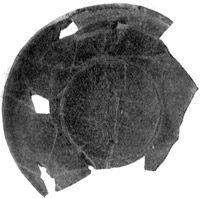
|
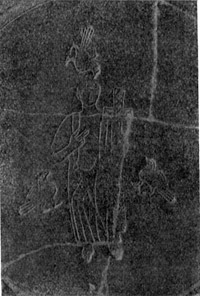
|
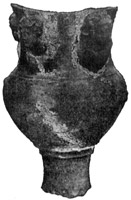
|
| Fig. 74а |
Fig. 74б |
Fig. 75 |
2. Within the monastery wall, the excavations
(Fig. 76)
were conducted in the area to the north-east of 1903 works. There, the excavations have uncovered sections of 4 streets, two longitudinal and two transverse, around which buildings of three periods (Ancient Greek, Romano-Byzantine, and Late Byzantine) are grouped
(the plan on Fig. 76
indicates them with different shading).
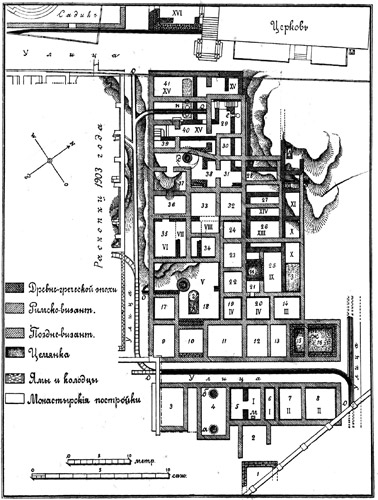
|
| Fig. 76 |
The excavations have revealed that all the periods had these streets going in the same areas. Ancient Greek houses XV and XVI are uncovered on either side of the north transverse street; they indicate that the direction of the streets of the Greek period coincides with that of later periods and supply evidence that the city had regular planning as early as the most ancient period. In the northern part of the territory excavated in the given year, there was large house of the Greek period
XV on the plan at
Fig. 76
Its north wall overlooked the longitudinal street and survived as long as 17.09 m; its west wall went on the transverse street and survived as long as 12.80 m. The other sides are just lines and a partly completely destroyed. There was basement
floor that only survived of house XV, it kept its full height (2.13 m to the beginning of ceiling beams). Besides the plan on
Fig. 76,
Figs. 77
and
Fig. 78
supply information of the remains of building XV represents the basement and building
Г (unearthed in 1903) viewed from the transverse street, and Fig. 78 — from the monastery apiary. Two staircases (in rooms nos. 29 and 40)
lead from the basement to the upper floor. Both start from a corridor that is T-shaped in plan. Three doors open from the same corridor to north basement rooms.
According to the remains of fired wood on the floor, the upper floor of house XV perished in conflagration, and the remains of its ashlar walls were dismantled in modern time
when building the monastery. Room н of house XV contained elongated pit in bedrock with three circular hollows possibly for placing pithoi in them.
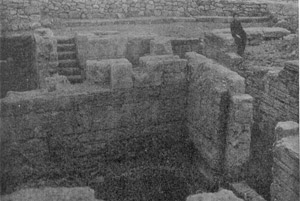
|
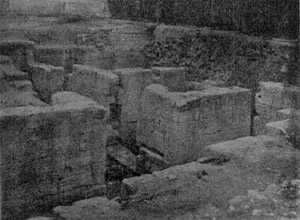
|
| Fig. 77 |
Fig. 78 |
The excavation of room н has revealed 43 bronze circles that, according to some scholars, were used as a material for minting coins.
In the north wall of room 29, there was a window
(Fig. 79)
that overlooked absorption well, cylindrical in shape, which was cleaned as deep as 5 m. The excavation near the south wall of house XV has unearthed pear-shaped cistern д, which consists of rubblework with
lime on top (0.80 m in diameter) and is carved into bedrock below (being 3.55 m in diameter). There is a special pit made in the side of the cistern for desilting of water
(see the plan and cross-section in
Fig. 80
).
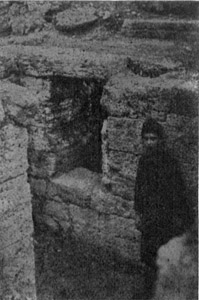
|

|
| Fig. 79 |
Fig. 80 |
The excavation of house XV has discovered a fragments of limed cornice (1.10 х 0.32 х 0.27 m) with relief frieze of rosettes and palmettes above free designs
(Fig. 81)
Greek house V contained grain pit к where well г was dug in a later period; pottery pipes connected this well with another well в (of a later period as well).
Greek house I overlooked the south transverse street. The excavation has unearthed there, at the south wall, limestone altar м
(Fig. 82)
with a snake twined around it, putting its head to the centre of top surface of the altar, where round pit is made. The snake keeps traces of painting. There were seven simple clay lamps discovered around the altar.
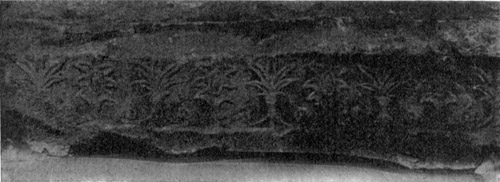
|
| Fig. 81 |
The channels, which have been uncovered on the streets, date to the Byzantine period. The excavation in room no. 4, which dates to the same period, has revealed two pear-shaped wells а and б.
Besides that, the excavated area has appeared to include also grain pits ж (with remains of salt fish), з, и and л.
Apart from the already mentioned finds, the excavations within the monasterial estate have discovered different architectural fragments, Greek and Latin inscriptions
[2]
, fragments of marble sculptures, fragment of limestone relief with image of meal partaking by heroized dead person, fragments of different vessels of marble and stone, marble and stone pestles and grinders, hones, fragments of Byzantine marble relief
(Fig. 83)
, millstones for hand mills, small throwing stones, stone spindle whorls, gold earrings, silver thurible decorated with stamped busts of saints within medallions, palmettes and flowers, bronze censer, foot of a bronze statue, fragments of bronze vessels, solid bronze ring with blind riveted bolt, massive bronze belt buckle with relief image of a lion tearing a bull
(Fig. 84)
, other bronze buckles, brooches, fishhooks, keys, weights, coins, crosses, spear-tips and arrowheads, massive hook for hanging icon lamp, Byzantine lead seal, lead tessera with image of bust of
Hermias and bucraneum, various iron tools, spear-tip. The excavations have also discovered a number of different ceramic fragments: of red-figured, black-slip, red-slip (there is an interesting fragment
of cup bottom with picture of enthroned Serapis), simple earthenware (among the others, there was a fragment of tureen with relief medallion representing bust of a man) and glazed vessels, fragments of lamps
decorated with stamped reliefs, amphora necks and handles with stamps (from Chersonesos, Rhodes, Thasos, Sinope, etc.), head of terracotta statuette of a woman
(Fig. 85)
, top corner of a small terracotta altar, clay spindle whorls, playing balls and checkers, sinkers (there are pieces with stamped images and various stamps containing names and monograms), bone awls, spear,
checkers, knife handle, spoon with short pointed handle, wild boar’s fangs, materials for making bone goods (goat’s horns), glass vessels, glasses from finger-rings, glass bracelets, playing checkers, remains
of stock of products.
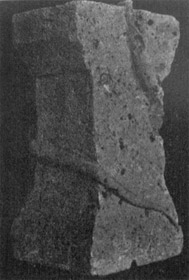
|
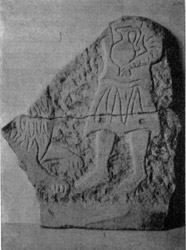
|

|
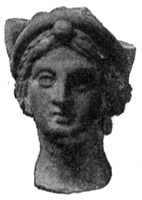
|
| Fig. 82 |
Fig. 83 |
Fig. 84 |
Fig. 85 |
3. 3. The excavations near the Uvarov basilica and baptistery have uncovered the area limited by the sea from the north and longitudinal street from the south. The excavations to the east of the baptistery have uncovered ruins of church
А
(Fig. 86)
, which plan is the same as that of the church unearthed in the south-east section of the ancient city in 1827 and investigated in 1891
[3]
.
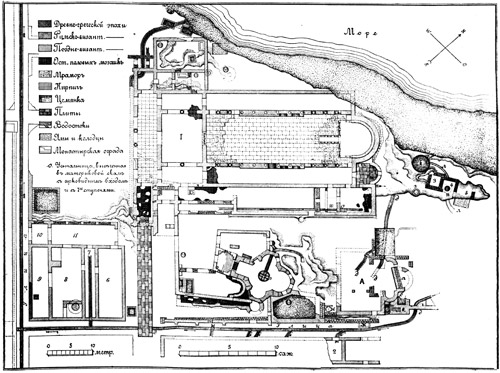
|
| Fig. 86 |
Similar to the above-mentioned church, church А has three apses. Its central, big apse is located above more ancient grain pit а. This pit was filled with soil and fine stone and reinforced with transverse wall,
which was laid with lime. To the north of this pit, there is another one, discovered in 1901, which also is a remain from more ancient period. To the south of the southern apse, there were partly survived brick floor
(в) and two rectangular cemented hollows б and г. In front of the west wall of the church, on the south side, there was absorption well е located in a special, fenced off room.
The excavations to the south of the church have uncovered tomb ж, which was filled with bones. Church А was destroyed in a relatively early period, so the Late Byzantine period was the time when new buildings
and drainage channels д—д were erected above the ruins of the church; these channels connected with the channel discovered in 1901. The excavations on the sea coast to the north-east of church А, under the altarless
church that was discovered in 1901 and was recently destroyed in course of building of new batteries, have revealed remains of a construction that consisted of three rooms (nos. 3-5) with three circular wells,
carved into bedrock and plastered with opus signinum (з, и, к; the latter well was connected with room no. 4 by channel л). To the south of church А, there was the first (from the north) longitudinal
street that connected with the transverse street, which came to the above-mentioned longitudinal street and, after it, finished with narrow side-street, which was paved with slabs. This side-street continued with stone
stairs leading to a platform paved with mosaics. To the west from the narrow side-street, which lead to the Uvarov basilcia, there were residential rooms nos. 6-11. Finally, the excavations have revealed remains of small
three-aisled basilica with mosaic trim, which was located to the south of the longitudinal street. In the transverse and longitudinal streets, there were drainage channels with a number of branches flowing into them.
The excavations in this area of the ancient city have uncovered the following ancient artifacts: fragments of marble capitals of columns
(Fig. 87)
and other architectonic fragments, Greek
[4]
and Latin
[5]
inscriptions, fragmented marble statuette of a woman
(Fig. 88)
, marble head of a man
(Fig. 89)
, other fragments of marble sculptures, fragments of different vessels of marble
(Fig. 90
represents a fragment of Byzantine vessel with relief cross), fragment of Byzantine marble relief)
(Fig. 91)
, different coins, bronze crosses and icons, small closed bell, fragment of a chain, buttons, finger-rings, thimble, needles, fishhooks, lead, stone and clay sinkers, stone millstone with side hole for rotating stick
(Fig. 92)
, clay and stone spindle whorls, clay playing balls, shards of black-slip, simple earthenware and glazed vessels (an interesting fragment is represented on
Fig. 93
), shards of glass vessels, shards of glass bracelets, bone awls, checkers, carved bone plaque with image of running warrior
(Fig. 94)
, bone statuette of a man with missing left hand, feet and head
(Fig. 95)
, wild boar’s tusks, materials for making goods of bone.
4. See
Fig. 96
for the general plan of the necropolis near the monastery gate with uncovered tombs nos. 1524-1553, and
Fig. 97
for the plan of graves (nos. 1554-1635) located near the Greek-cross plan church. The excavations in the former area have uncovered, apart from the graves, solid drain в, made with opus signinum, under which goes another
drain б, made of pottery pipes, which is parallel to another drain б1, and absorption well г, which was probably aimed to receive sewage water that went out of the city through the wall by stone pipe а,
bedrock was carved in the form of channel at place where it went out of the wall.
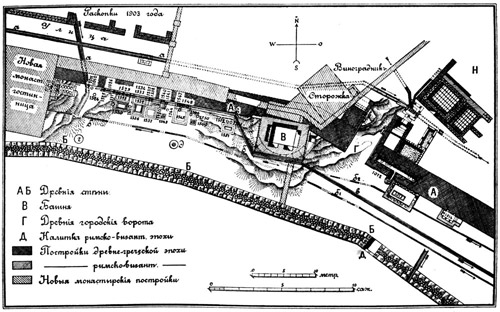
|
| Fig. 96 |
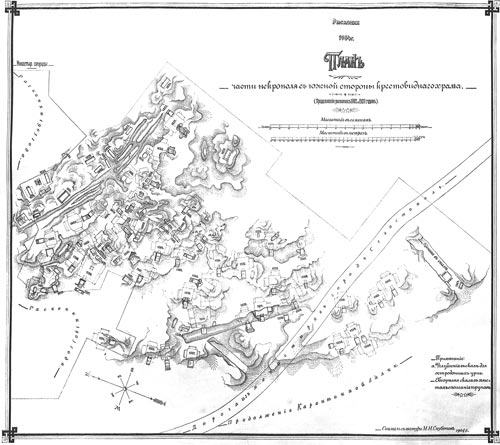
|
| Fig. 97 |
The excavations 8.65 m far from grave no. 1553 have discovered lower half of rectangular tower В of the Romano-Byzantine period, which was built above the foundation of a big round Ancient Greek tower that was carved into bedrock
(Fig. 96)
Rectangular tower В is of excellent state of preservation
(Figs. 98,
99,
100,
101
)
, especially so is its inner part
(Fig. 102)
with six lines of masonry in situ, 2.90 m high. This tower ceiling rested on five rectangular buttresses; there were stone benches 0.63 m wide arranged in between of the buttresses. The tower is located just below the road leading to the monastery gate
(Fig. 101)
.
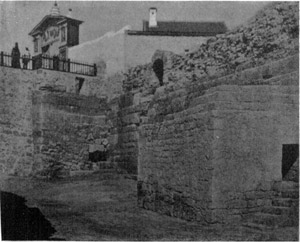
|
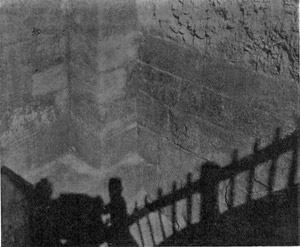
|
| Fig. 101 |
Fig. 102 |
As for the shapes of graves discovered in the year under report, all of them are well-known because of the previous years of excavations. Cremations were often, cremated bones were put into urns, which were either placed separately or put into slabbed and tiled graves. Sometimes, the same grave received inhumations together with fired bones in urns.
Sometimes, the urns received inscriptions with the names of cremated persons

Tomb no. 1545 is a well-preserved construction in the form of stepped pyramid
[6]
Fig. 97
allows one to make conclusions concerning the size and shape of vaults with passages and niches. Sometimes, niches in vaults are made in the form of deepened boxes and the closing barriers were of big marble slabs. Grave no. 1622 is interesting from the point of view of vault-cutting technique
[7]
. The vaults were obviously made in advance and offered for sale
[8]
. Some vaults have visible traces of wall-plaster. It was a later (Christian) period when some ancient vaults were used as dwelling-places for the poor. It appeared that the skeletons in grave no. 1595 have deformed skulls. In grave no. 1534, there was a skeleton without skull.
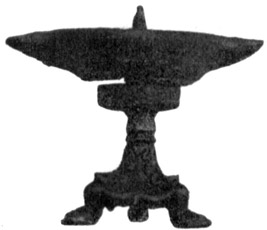
|
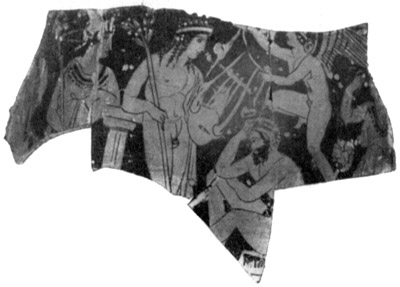
|
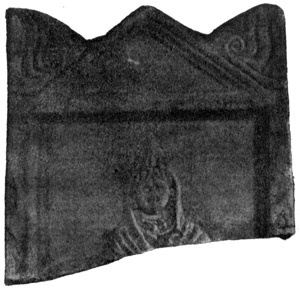
|
| Fig. 103 |
Fig. 104 |
Fig. 105 |
The excavations of the necropolis have revealed a number of ancient artifacts: sheets of gold, earrings, finger-rings (there is one with carnelian), tube with three eyelets for hanging, decorated with leaves, rosettes, scrolls, plaits and balls in filigree technique (a stone from the big semicircular socket and circles that closed the tube from both sides are missing), 13 badges in the shape of pointed caps with two holes for hanging
[9]
, silver spoons and buckle, bronze bracelets, brooches, earrings, buckles, lock with the key, keys, thimble, rod, mirrors, coins, lamp stand
(
Fig. 103
; the stand held clay lamp), spoon (uncovered together with marble plate; they could be coroplasts’ tools)
[10]
, fragment of a chain, iron knives, athlete’s scrapers, spear-tip, finger-rings, buckles, fragment of big tube with two chains for wearing, clay pottery (red-figured shards, one of which is represented on
Fig. 104
, showing Apollo’s victory over Marsius, black-slip vessels, Megarian bowls, red-slip vessels including shards of stamped ones, simple earthenware pottery, shards of stamped amphorae), fragments of stamped roof tiles, glass vessels (including shards of Phoenician vessels), round glasses for finger-rings (there are carved ones), glass finger-ring and bracelet, fragments of stone hammer (tied up with bronze wire with a loop above, near the pointed end, so it was probably used as a plummet), hone with a hole, fragment of graves stele of marble
(Fig. 105)
, marble boards to be inserted into limestone grave steles, limestone gravestones of various forms, inscriptions
[11]
, foot of a marble statue with base, various architectonic fragments, marble slab with chamfered edges, wild boar’s tusk, knucklebones, carved bone pyxis, spoon in the same technique, different pierced beads, beads and pendants.
|



